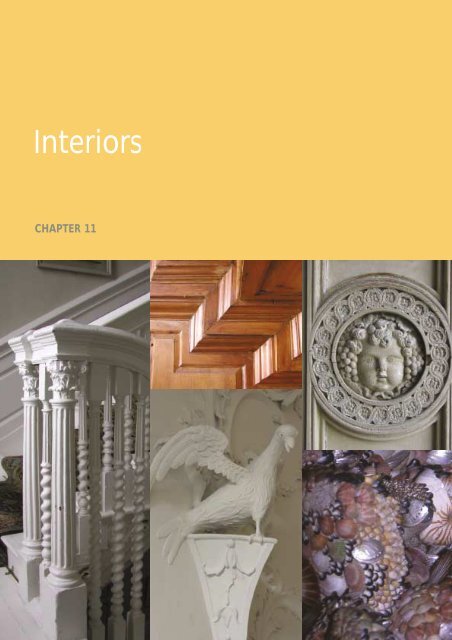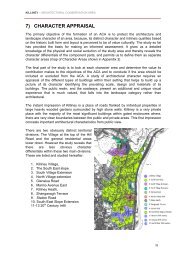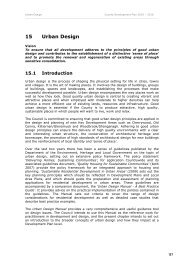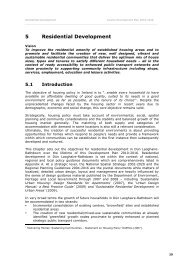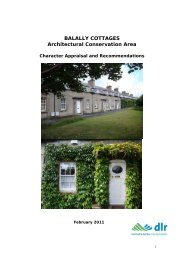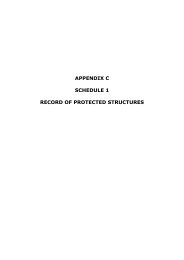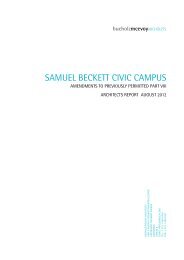Chapter 11 Interiors
Chapter 11 Interiors
Chapter 11 Interiors
You also want an ePaper? Increase the reach of your titles
YUMPU automatically turns print PDFs into web optimized ePapers that Google loves.
<strong>Interiors</strong><br />
CHAPTER <strong>11</strong>
Architectural Heritage Protection Guidelines for Planning Authorities<br />
The interior of a protected structure<br />
is of primary importance to its<br />
character. Ideally, the special interest<br />
of the interior should be assessed<br />
when initially protecting the structure,<br />
but failing that, it should be<br />
evaluated when proposals are put<br />
forward to redevelop the structure.<br />
The importance of an interior is not<br />
confined to decorative features: the<br />
plan form or the structural system<br />
itself may be innovative, as in this<br />
early multi-storey, steel-framed store<br />
house<br />
CHAPTER <strong>11</strong> INTERIORS<br />
<strong>11</strong>.1 Introduction<br />
<strong>11</strong>.1.1 The interior of any protected structure is of primary<br />
importance. Although the interiors of many<br />
protected structures are not accessible to the<br />
general public, they may nonetheless be essential to<br />
the character and special interest of that building<br />
and are therefore protected.<br />
<strong>11</strong>.1.2 Protection extends to all features of quality and<br />
interest in the interior of a protected structure, not<br />
only to those features which are original. In making<br />
an assessment of the interior of a protected<br />
structure, a planning authority should obtain all<br />
necessary expert and specialist advice. This<br />
assessment should ideally be carried out on a roomby-room<br />
basis. Consideration should be given, in<br />
each room or space, to elements such as the floor,<br />
ceiling and walls and any interesting features or<br />
fittings present. An overall assessment of the interior<br />
and the interrelationship of different spaces should<br />
also be made.<br />
<strong>11</strong>.1.3 Items to consider in the assessment of an interior<br />
include:<br />
a) Does the structure retain its original plan-form<br />
b) If not, are there any alterations or additions of<br />
interest<br />
c) Have the proportions of the rooms or spaces<br />
been altered Have they been damaged by<br />
alteration, improved or merely changed<br />
d) Are there any interesting, planned relationships<br />
between rooms or spaces, such as enfilades,<br />
processional routes, industrial processes and the<br />
like Have these been altered or interrupted by<br />
changes or created out of previously existing<br />
spaces<br />
e) Is there a hierarchy to the various spaces How<br />
do the principal spaces relate to the subsidiary<br />
ones; for example, dining rooms to kitchens or<br />
banking halls to offices<br />
f ) Is the relationship of the spaces or the layout of<br />
rooms of interest because of the insight it gives<br />
into the workings of a bygone time; for example,<br />
the relationship of cells to a courtroom or a<br />
milling room to a store<br />
171
Architectural Heritage Protection Guidelines for Planning Authorities<br />
CHAPTER <strong>11</strong> INTERIORS<br />
g) Are there elements of interest in the interior<br />
such as early iron and concrete floors, timber<br />
stud partitions, lath-and-plaster ceilings, exposed<br />
roof trusses<br />
h) Is there any joinery of quality such as internal<br />
doors, window shutters, skirting boards, dado<br />
rails, architraves, wall panelling<br />
i) Are there finishes of interest to flooring, walls or<br />
ceilings<br />
j) Are there any surviving original or good quality<br />
decorative schemes These might include<br />
limewash, paint, wallpaper, wall-paintings, painted<br />
ceilings, tiling, gilding, and other finishes.<br />
k) Are there any fixtures or features which are<br />
original to the building or of architectural or<br />
historical interest; for example fireplaces, counters<br />
or benching<br />
l) Is there surviving machinery connected with a<br />
building’s present or former use, such as milling<br />
machinery, early lifts or dumb waiters<br />
Whereas an important fixture of this interior was retained in the<br />
gallery of this former church; the original plastering, floor and<br />
other fixtures have all been lost. Even if an accurate reproduction<br />
of the missing features and decoration were to be undertaken,<br />
the result would largely be a new interior<br />
<strong>11</strong>.1.4 Where features are considered to be worthy of<br />
protection, they should ideally be retained in situ.<br />
Even where elements or features are decayed or<br />
damaged, they should be repaired rather than<br />
replaced. Repairs and alterations should be carried<br />
out in a manner appropriate to the individual<br />
element or structure and preferably in a manner<br />
that is readily reversible.<br />
<strong>11</strong>.2 Elements of the Interior<br />
Plan-form<br />
IDENTIFYING SPECIAL FEATURES FOR PROTECTION<br />
<strong>11</strong>.2.1 The plan-form of a building is one of its most<br />
important characteristics. Where the original planform<br />
remains, or is readily discernible, it should be<br />
identified and respected. Later alterations of definite<br />
architectural merit should also be identified for<br />
protection.<br />
172<br />
CONSIDERATION OF PROPOSALS AFFECTING<br />
PLAN-FORM<br />
<strong>11</strong>.2.2 Where alterations are essential for the continued<br />
viability of a building with an interior of value,<br />
attempts should be made to keep works to a<br />
minimum and preferably confined to areas of<br />
secondary importance. For example, where existing<br />
internal doorways are to become redundant, as a<br />
result of alterations to a structure, the doors should<br />
be retained in position and simply locked shut, rather<br />
than stripped out and the opening blocked up.<br />
The arrangement and inter-relationship of rooms and circulation<br />
spaces in an interior – here a top-lit long gallery in a large house<br />
– are key to how the building was designed to work and to be<br />
experienced. Proposals to change the plan form and alter or<br />
introduce new circulation routes should therefore be closely<br />
scrutinised
Architectural Heritage Protection Guidelines for Planning Authorities<br />
<strong>11</strong>.2.3 Wherever possible, the alterations should not<br />
change the interrelationships or the proportions of<br />
prominent spaces such as entrances, staircases or<br />
principal rooms. In a protected structure that retains<br />
its original spatial layout, proposals to subdivide the<br />
building into several smaller units or to open up a<br />
pair or series of rooms to create a larger space<br />
should be permitted only in exceptional<br />
circumstances after very careful scrutiny by the<br />
planning authority.<br />
CHAPTER <strong>11</strong> INTERIORS<br />
<strong>11</strong>.2.4 Where an earlier, unsatisfactory subdivision or<br />
opening up of rooms or spaces has taken place, in a<br />
manner which has distorted the original design, the<br />
opportunity could be taken to reinstate the earlier<br />
plan-form. Such inappropriate alterations could<br />
include the subdivision of principal rooms to form<br />
smaller rooms, lobbies or corridors, the addition of<br />
partitions which divide or obscure windows or<br />
obstruct designed circulation patterns.<br />
The practice of the recent past of subdividing large rooms<br />
by forming boxed cubicles within the space has only one<br />
advantage: it makes their removal less complicated and<br />
damaging than if the partitions extended up to the ceiling.<br />
However, the reversibility of this type of work may not always<br />
justify the insertion of new partitions into high-quality<br />
architectural interiors<br />
<strong>11</strong>.2.5 Reinstatement work, such as the removal of later<br />
partitions or lobbies, should generally be undertaken<br />
where it can be readily achieved and does not<br />
involve the loss or damage of later alterations of<br />
quality.<br />
Floors<br />
<strong>11</strong>.2.6 All floor structures of interest, which could include<br />
structural members such as timber, iron or steel<br />
beams, trusses, joists and brackets and floor finishes<br />
or surfaces of interest, should be identified and<br />
respected, whether or not they are original. Finishes<br />
could include marble or stone paving, timber<br />
boarding or blocks, scagliola, tiles, cobbling, brick,<br />
rammed earth, lime ash, plaster, terrazzo, or early<br />
concrete.<br />
Not just the visible finishes of a floor but also<br />
its structural elements may be of special<br />
interest. The painting of floors to imitate tiling<br />
is an unusual feature of some eighteenthcentury<br />
houses; here the painted diamonds<br />
are shaped with pleasing eccentricity to fit<br />
into the available space<br />
<strong>11</strong>.2.7 Efforts should be made to retain these floor types<br />
and any others of interest. Associated architectural<br />
details such as cast-iron floor grilles should generally<br />
be conserved even where they have become<br />
redundant.<br />
CONSIDERATION OF PROPOSALS AFFECTING FLOORS<br />
<strong>11</strong>.2.8 Where historic flooring exists, due care should be<br />
taken when works are undertaken for the<br />
installation or repair of services or the installation of<br />
thermal or acoustic insulation or for fire-safety<br />
enhancement works. Many types of floor finish are<br />
easily damaged and difficult to re-lay and should<br />
not be disturbed without good reason. Where a<br />
floor of particular interest or merit exists, an<br />
alternative service route should be found in order to<br />
avoid the disturbance of the floor. For example, this<br />
may be the case where a previously undisturbed<br />
Taking up and relaying stone flags to accommodate underfloor<br />
heating and other services is delicate work which has the<br />
potential to cause irreparable damage if incorrectly or clumsily<br />
done. The use of skilled personnel is necessary to avoid cracking<br />
or damage to the arrises of the flags<br />
173
Architectural Heritage Protection Guidelines for Planning Authorities<br />
CHAPTER <strong>11</strong> INTERIORS<br />
floor is made of doweled floorboards, which would<br />
be irreparably damaged by lifting. Flooring such as<br />
terrazzo, scagliola and other composition materials<br />
are also extremely easy to damage and difficult to<br />
repair.<br />
<strong>11</strong>.2.9 The cutting of old timber joists for new services<br />
should be avoided or kept to a minimum. It should<br />
be a requirement that any historical features, such as<br />
acoustic insulation or fire-proofing incorporated<br />
within the floor structure, should be preserved<br />
wherever possible. Where the need for improved fire<br />
protection demands the removal of such pugging, a<br />
full recording of the floor details should be<br />
undertaken before works commence.<br />
<strong>11</strong>.2.10 Original floors and floor levels should be retained<br />
where they survive. In structures where the floor to<br />
ceiling heights are considered too low for modern<br />
habitation, consideration could be given to<br />
excavating the ground floor level or to raising the<br />
collars or ties of the roof in order to avoid raising<br />
wall heads. However, for an interior of significant<br />
quality or rarity, such proposals may not be<br />
acceptable.<br />
These sixteenth-century corbels continued to be used after an<br />
early alteration that raised the ceiling height. This change is of<br />
interest, adding to our knowledge of the evolution of the<br />
structure, but a similar proposal made today would require<br />
very careful scrutiny<br />
174<br />
Floor strengthening<br />
<strong>11</strong>.2.<strong>11</strong> Any works to strengthen the floors of an existing<br />
building can be very invasive. Major disturbance can<br />
be caused to floor surfaces, skirting, panelling,<br />
architraves, hearthstones, ceilings and cornices. All<br />
options should be considered to avoid irreversible<br />
damage or needless disturbance of important<br />
features.<br />
<strong>11</strong>.2.12 There are no standard methods of strengthening<br />
the floors of old buildings. Where floor<br />
strengthening is proposed, the applicant should be<br />
able to show that there will be a minimum<br />
disturbance of good quality finishes and a minimum<br />
loss of historic fabric such as floor timbers. Other<br />
options should also be explored, such as restricting<br />
the location of heavy loads to basement areas or to<br />
areas of little architectural interest where the floors<br />
can be strengthened without damage to important<br />
features. Low-key methods of stiffening floors are<br />
often possible and practicable using traditional<br />
methods and materials such as scarfing on new<br />
timber, the use of flitch beams and other solutions.<br />
<strong>11</strong>.2.13 Any substantial strengthening work should be<br />
carried out under the guidance of an appropriately<br />
qualified structural engineer with knowledge and<br />
experience of historic buildings. Methods and<br />
specification for the works should be approved by<br />
the planning authority before any works commence.<br />
Proposals to strengthen historic floor structures should take<br />
account of the potential impacts on the fabric of the building<br />
and any existing finishes that would be disturbed to<br />
accommodate it. In this case, the main beam supporting the<br />
floor above is a scarfed beam. The scarfing may be original to<br />
enable the beam span a wide space, but could also signify an<br />
old repair, in which case the reasons behind the earlier repair<br />
work should be investigated to rule out the possible overloading<br />
of the floor structure<br />
Walls and partitions<br />
may be of interest due<br />
to archaic methods of<br />
construction, unusual<br />
materials or high quality<br />
of finish. Whether<br />
original or a well-crafted<br />
later intervention, as is<br />
this panelled bedroom<br />
corridor, internal walls<br />
and partitions can<br />
contribute to the special<br />
interest of the structure
Architectural Heritage Protection Guidelines for Planning Authorities<br />
Internal walls and partitions<br />
IDENTIFYING SPECIAL FEATURES FOR PROTECTION<br />
<strong>11</strong>.2.14 The walls and partitions in historic buildings may<br />
often be of interest in themselves and include<br />
examples of rare or interesting construction<br />
methods.<br />
<strong>11</strong>.2.15 Earlier fireplaces, openings or decoration may be<br />
hidden behind later work. In protected structures<br />
where there are likely to be concealed features, the<br />
internal walls should be carefully investigated in<br />
advance of any alterations being carried out.<br />
However, where an earlier feature is known to be<br />
concealed by a later decorative scheme of interest,<br />
the later decoration should generally not be<br />
disturbed in order to reveal or investigate the earlier<br />
feature.<br />
Later finishes or features may cover earlier elements of interest<br />
such as this sixteenth-century doorway, partly covered by reused<br />
original panelling and an eighteenth-century doorcase; it<br />
may be necessary simply to record the earlier feature while<br />
retaining the high-quality later work in place undisturbed<br />
CHAPTER <strong>11</strong> INTERIORS<br />
CONSIDERATION OF PROPOSALS<br />
<strong>11</strong>.2.16 In addition to the loss of historic fabric, the removal<br />
of internal structural walls or chimney breasts also<br />
has the potential to jeopardise the structural<br />
stability of a building and any proposals should be<br />
given careful consideration.<br />
<strong>11</strong>.2.17 Where new partitions are proposed, they should be<br />
installed in such a way that they can be removed at<br />
a later stage with little or no damage to the historic<br />
fabric. New partitions should not cut through<br />
decorative plasterwork, finishes or joinery but be<br />
scribed around them with extreme care and<br />
accuracy. The installation of new partition walls<br />
should generally be avoided in high-quality interiors.<br />
<strong>11</strong>.2.18 The formation of new openings in existing walls or<br />
partitions should be minimised, or avoided<br />
altogether, in an interior of quality, as this inevitably<br />
leads to the destruction of existing fabric. Such<br />
damage can rarely be satisfactorily reversed. Some<br />
injudicious alterations may include the removal of<br />
plaster from brick-nog partitions, while the cutting<br />
of new openings in braced partitions may result in<br />
structural failure.<br />
New partitions, where considered acceptable, should avoid<br />
disturbing historic fabric. They should be scribed around<br />
cornices, dado rails and skirtings to allow removal without<br />
damage. However, it is not generally recommended that<br />
important spaces within a protected structure be subdivided<br />
even if the subdivisions are reversible<br />
<strong>11</strong>.2.19 The addition of internal insulation or dry-lining to a<br />
protected structure should only be permitted where<br />
this would not adversely affect important internal<br />
features of interest such as cornices, wall panelling,<br />
skirtings, windowcases and doorcases or decorative<br />
finishes.<br />
Ceilings<br />
IDENTIFYING SPECIAL FEATURES FOR PROTECTION<br />
<strong>11</strong>.2.20 Ceilings that have plaster decoration are important<br />
features in an interior. Even plain plaster that is old<br />
is also of interest, particularly if it was applied onto<br />
Evidence may survive on a plastered vaulted<br />
ceiling or arch of the wicker centring used in<br />
forming the vault, seen in the hollows left by<br />
the wickerwork which was embedded in the<br />
plaster and left there when the centring was<br />
removed. In some rare examples, pieces of<br />
wickerwork also survive<br />
175
Architectural Heritage Protection Guidelines for Planning Authorities<br />
CHAPTER <strong>11</strong> INTERIORS<br />
timber laths. Decorative plasterwork may include<br />
highly decorated enrichments or relatively simple<br />
cornices. Ceilings may also be painted or<br />
incorporate painted panels.<br />
<strong>11</strong>.2.21 Exposed roof or ceiling structures are of<br />
architectural interest and important to the character<br />
of an interior. These might include timber joists or<br />
trusses or iron beams. There may be associated<br />
details of interest to a ceiling such as iron or timber<br />
ventilation and heating grilles, lighting fixtures or<br />
chandelier winches.<br />
CONSIDERATION OF PROPOSALS AFFECTING<br />
CEILINGS<br />
<strong>11</strong>.2.22 It should be noted that where there is a proposal to<br />
alter or dismantle a historic decorative or plain<br />
plaster ceiling, the alternatives should first be<br />
considered. Irregularities in a ceiling surface do not<br />
necessarily indicate problems which require the<br />
ceiling to be demolished. An undulating ceiling<br />
surface may need to be appreciated as part of an<br />
old building. Proposals to replace or alter the<br />
supports of a historic ceiling should be carefully<br />
scrutinised.<br />
Lath and plaster ceilings or walls without<br />
embellishments may appear unimportant, but the<br />
craftsmanship in their fabrication and the resulting<br />
gently undulating surface can be part of the<br />
character of a historic interior. Functional fixtures<br />
such as meat hooks, ventilation grilles or exposed<br />
beams contribute to the character (although<br />
plastered beams should generally not be exposed)<br />
<strong>11</strong>.2.23 Proposals to install new suspended ceilings should<br />
be carefully considered and care should be taken<br />
that they do not conceal original plasterwork or<br />
other features of quality and that their installation<br />
does not affect the proportions or character of an<br />
important room or the appearance of a building<br />
from the street. Whilst they may be considered<br />
acceptable in minor rooms, or in spaces without<br />
special interest, they should generally not be<br />
permitted where they conflict with the window<br />
head level and where this would affect the external<br />
appearance of a building. Where new suspended<br />
ceilings are permitted to be installed, the installation<br />
should be readily reversible without damage to the<br />
historic fabric of the building.<br />
Repairs to plastered ceilings should be appropriately specified to<br />
rectify any structural faults while avoiding unnecessary removal<br />
or reproduction of parts of the ceiling. Existing cracks and stains,<br />
while indicative of damage, should be monitored for ongoing<br />
problems before any invasive action is undertaken. Decorative<br />
ceiling plaster should be carefully repaired by an experienced<br />
conservation stuccadore, who may advise reinforcing the ceiling<br />
from above<br />
<strong>11</strong>.3 Finishes<br />
176<br />
Plasterwork<br />
IDENTIFYING SPECIAL FEATURES FOR PROTECTION<br />
<strong>11</strong>.3.1 Historic plasterwork should be identified and<br />
protected wherever possible. Not only decorative<br />
wall and ceiling plaster, but also plain, flat<br />
plasterwork are important parts of the internal fabric<br />
of a protected structure.<br />
This illustration, taken in the space above a previously-lowered<br />
ceiling, shows the drawback of carrying out such works; apart<br />
from the damage to the architectural character of the interior,<br />
the lowered ceiling has concealed problems caused by lack of<br />
maintenance to the fabric above it
Architectural Heritage Protection Guidelines for Planning Authorities<br />
CONSIDERATION OF PROPOSALS AFFECTING<br />
PLASTERWORK<br />
<strong>11</strong>.3.2 Care should be taken when permitting works such<br />
as chasing-in of electrical wiring that the minimum<br />
possible disturbance is caused to important wall or<br />
ceiling plaster. Where the plasterwork is of particular<br />
importance or rarity, chasing-in should be avoided.<br />
Disturbance should not be permitted to decorative<br />
plasterwork such as cutting through or across<br />
mouldings or installing downlighters.<br />
<strong>11</strong>.3.3 Where older, soft lime-based plasters are to be<br />
repaired, repairs should be carried out using a<br />
plaster that matches the existing material on a likefor-like<br />
basis while allowing it to be clear on close<br />
inspection which is the original material.<br />
Decorative plasterwork is of prime importance in historic<br />
interiors. Not only is it aesthetically pleasing, it can also be<br />
used to indicate dates of construction or alteration. The best<br />
eighteenth-century Irish plasterwork has an international<br />
reputation, but the more modest examples found countrywide<br />
are of importance to the houses, churches, town halls, railway<br />
stations and other building types which they embellish<br />
CHAPTER <strong>11</strong> INTERIORS<br />
Joinery<br />
IDENTIFYING SPECIAL FEATURES FOR PROTECTION<br />
<strong>11</strong>.3.4 Elements of internal joinery often survive in large<br />
quantities in historic buildings. They can include<br />
doors, doorcases, windows, windowcases, skirtings,<br />
dado rails, panelling, staircases and fireplaces. The<br />
doorcases and windowcases can consist of<br />
architraves, plinth blocks, door leaves, panelled<br />
reveals and window shutters. Surviving door and<br />
window furniture such as hinges, locks, lockcases,<br />
door handles, shutter bars and the like should be<br />
preserved even when redundant.<br />
CONSIDERATION OF PROPOSALS AFFECTING<br />
JOINERY<br />
<strong>11</strong>.3.5 The planning authority should encourage the careful<br />
repair of the historic fabric with an emphasis on the<br />
conservation of as much as possible of the old<br />
material. Large-scale renewal of sections of joinery<br />
for the sake of convenience should be avoided. In<br />
repairing joinery, only the minimum amount of<br />
timber should be replaced using timber of a<br />
matching species and grain type. New pieces, where<br />
required, should be carefully jointed in. The profiles<br />
of decayed sections of moulded work should be<br />
copied exactly and spliced precisely into the<br />
existing work. The use of substitute materials such<br />
as glass-reinforced plastic to simulate carved joinery<br />
should not be permitted in interiors of architectural<br />
merit.<br />
Plaster is generally a robust material, but continuous saturation<br />
can cause severe damage, both to the plasterwork and its timber<br />
supports, and provoke fungal attack in the latter. The fabric of the<br />
building will require drying out before an assessment can be<br />
made as to the extent to which replacement of plaster is<br />
necessary<br />
The internal joinery of a<br />
protected structure, whether<br />
original or good-quality later<br />
additions, is often aesthetically<br />
pleasing in addition to being<br />
well-crafted from high quality<br />
timber with good metal fittings.<br />
Joinery elements, whether of<br />
painted softwood or elaborate<br />
polished mahogany, are key<br />
indicators of the date and social<br />
status of a historic structure and<br />
provide a physical record of the<br />
alterations made to it<br />
throughout its history<br />
177
Architectural Heritage Protection Guidelines for Planning Authorities<br />
CHAPTER <strong>11</strong> INTERIORS<br />
Timber is eminently capable of repair. Splicing, scarfing and<br />
other traditional methods of work that retain the maximum<br />
amount of sound material are still carried out effectively and<br />
unobtrusively by skilled conservation joiners<br />
The intact survival of delicate internal finishes such as historic<br />
wallpaper or stencilling is unusual; however, in this illustration,<br />
an entire early twentieth-century heraldic scheme has survived<br />
in a vaulted entrance lobby and been retained despite a recent<br />
change of use<br />
The installation of new locks, catches, hinges, door-closers and<br />
other items to high-quality joinery, such as this mahogany<br />
door, can be carried out with care but should not necessitate<br />
the removal of surviving historic fittings even where these have<br />
become redundant. The removal of inappropriate later fittings<br />
can cause as much damage as their installation: the<br />
consequent repair is a specialist task<br />
The repainting or redecoration of walls, or parts of walls,<br />
which never had important decorative schemes will not affect<br />
the character of an interior but the opposite will be the case<br />
where there are details of interest, such as these historicallyimportant<br />
mural panels<br />
178
Architectural Heritage Protection Guidelines for Planning Authorities<br />
Decorative finishes<br />
IDENTIFYING SPECIAL FEATURES FOR PROTECTION<br />
<strong>11</strong>.3.6 Important early schemes of interior decoration<br />
should be identified and preserved wherever<br />
feasible. Decorative finishes of interest may include<br />
paint, wallpaper, anaglyptic papers, wall or ceilingpaintings,<br />
stencilling, decorative paint finishes,<br />
gilding, tiling and other forms of decoration. Where<br />
such decoration exists, and is clearly part of the<br />
character of the protected interior or is of historical<br />
interest, it should be retained and conserved.<br />
CHAPTER <strong>11</strong> INTERIORS<br />
CONSIDERATION OF PROPOSALS AFFECTING<br />
DECORATIVE FINISHES<br />
<strong>11</strong>.3.7 No issue arises with the routine redecoration of<br />
rooms which have lost, or perhaps never had,<br />
important decorative schemes. However, where<br />
decorative schemes or details survive which are part<br />
of the character and special interest of the building<br />
these should generally not be over-painted or<br />
destroyed. Surviving decorative finishes need careful<br />
assessment and can be simply left as found,<br />
cleaned, restored or reproduced as appropriate.<br />
Fragments of handmade wallpaper are occasionally uncovered<br />
beneath later finishes; where this occurs it may be appropriate<br />
either to record and retain them in position or to allow for their<br />
careful removal and conservation. It may be possible – if<br />
sufficient evidence survives – to reproduce historic wallpaper,<br />
should the restoration of the original decorative scheme be of<br />
great importance to the interior. Consideration should be given<br />
to the fact that the change of use of a room could affect the<br />
conservation of a delicate wall finish such as wallpaper, whether<br />
from direct damage or from changed levels of relative humidity<br />
<strong>11</strong>.3.8 Where there is reason to believe that earlier<br />
decoration of some quality survives below later<br />
layers, specialist advice should be taken as to<br />
whether to reveal it or how to conserve it. It could<br />
be a condition of a planning permission that any<br />
fragments of original or early decoration of merit,<br />
such as pieces of wallpaper, which come to light<br />
during renovation works, should be recorded and<br />
preserved where possible. Where there is extensive<br />
survival of a concealed decorative scheme of<br />
interest, specialist advice could be taken as to<br />
whether to reveal it or how to conserve it.<br />
<strong>11</strong>.3.9 Where the stripping of paint is proposed, it should<br />
be remembered that this action would eradicate the<br />
evidence of the original or early decorative schemes<br />
where traces of these have survived. This will make<br />
it impossible thereafter to determine the original or<br />
previous colouring or paint types. Where there is<br />
likely to be early, interesting paintwork below the<br />
present surface, consideration should be given to<br />
leaving a small area of the wall, ceiling or joinery<br />
unstripped or undertaking a proper detailed paint<br />
analysis before any stripping takes place. The<br />
method of paint-stripping should be appropriate to<br />
the underlying material. In particular, account should<br />
be taken of the material’s ability to withstand the<br />
stripping process. For example, old joinery should<br />
never be stripped by immersion as this will deform<br />
the timber and weaken the joints. Gesso ornament<br />
is not always identifiable when painted and is easily<br />
damaged by stripping off the overlying paint.<br />
Where existing paintwork is to be removed, and it is likely that<br />
evidence of an important decorative scheme survives, samples<br />
can be taken in advance to analyse the historic colours used as,<br />
once the paint is stripped, such evidence will be lost forever. The<br />
taking and analysing of paint samples is a specialised task. In<br />
the case illustrated, stripping has revealed an original joint in the<br />
dado rail (right hand of picture) showing the use of slightly<br />
differing sections, long hidden under layers of paintwork<br />
Burning-off defective paint is not recommended<br />
where the joinery is in situ because of the potential<br />
danger of fire to the entire building fabric.<br />
<strong>11</strong>.3.10 Where advice is sought from the planning authority,<br />
the opportunity could be taken to encourage a<br />
decorative scheme that is appropriate to the age<br />
and design of the building or room, as this will<br />
enhance the historic building.<br />
179
Architectural Heritage Protection Guidelines for Planning Authorities<br />
CHAPTER <strong>11</strong> INTERIORS<br />
Decorative items or works of art<br />
installed in an interior may be<br />
considered fixtures if they were<br />
intended to be an integral part of the<br />
design. In this case, the statue of<br />
Daniel O’Connell is a later addition,<br />
but is part of a group of statues<br />
positioned at key points around the<br />
rotunda adding to the special interest<br />
of the interior<br />
180<br />
<strong>11</strong>.4 Fixtures and Fittings<br />
Interior fixtures and features<br />
<strong>11</strong>.4.1 Protection includes all fixtures and features which<br />
form part of the interior of a protected structure. In<br />
some cases it may be difficult to establish whether<br />
or not a particular object or feature is a fixture.<br />
Although not defined in the Act, the term ‘fixture’<br />
implies a degree of physical annexation together<br />
with indications that the annexation was carried out<br />
with the intention of making the object an integral<br />
part of the structure. In an interior, elements such as<br />
fireplaces, panelling or doorcases are fixtures which<br />
form part of the building. However, free-standing<br />
objects may be considered fixtures if they were<br />
placed in position as part of an overall architectural<br />
design. For example, in an interior such as a<br />
courtroom, fittings such as seating, screens, canopies,<br />
and the like, while they may or may not be<br />
physically fixed, were designed or made to fit a<br />
specific space to form part of the design.<br />
<strong>11</strong>.4.2 Works of art, such as paintings or pieces of<br />
sculpture, placed as objects in their own right within<br />
a building, are unlikely to be considered as fixtures<br />
unless it can be proved that they were placed in<br />
particular locations as part of an overall architectural<br />
design. In such cases, the planning authority may<br />
need to take expert advice on assessing the<br />
contribution of the object to the character of the<br />
protected interior.
Architectural Heritage Protection Guidelines for Planning Authorities<br />
Staircases<br />
IDENTIFYING SPECIAL FEATURES FOR PROTECTION<br />
<strong>11</strong>.4.3 Staircases are often a major element of design<br />
within an interior. Iron or timber balustrades,<br />
handrails, decorative tread ends, moulded nosings<br />
and other stair details should be identified,<br />
respected and retained. Where the original service<br />
or back stairs in dwellings survive, these should also<br />
be retained.<br />
CHAPTER <strong>11</strong> INTERIORS<br />
CONSIDERATION OF PROPOSALS AFFECTING<br />
STAIRCASES<br />
<strong>11</strong>.4.4 The removal or alteration of an original or fine<br />
staircase should only be permitted in exceptional<br />
circumstances. Generally, stone stairs should be<br />
retained in their original state and should not be<br />
painted, nor have sealant applied to them.<br />
<strong>11</strong>.4.5 Where it is necessary for safety reasons to provide<br />
higher handrails or balustrades, it may be preferable<br />
to permit the addition of a new upper rail mounted<br />
above the handrail rather than allow the removal or<br />
remodelling of an important balustrade. Where this<br />
is not considered acceptable, for example on a<br />
landing, it may be necessary to consider measures<br />
to prevent people from approaching the low<br />
balustrade with an inner railing or similar barrier.<br />
Stone staircases can suffer damage from the effects of<br />
expanding and corroding cramps and chipping of nosings.<br />
The repair of damage by indenting new stone is a traditional<br />
practice and still successfully used. However, expertise is<br />
necessary to assess the structural engineering issues relating<br />
to damaged or failing cantilevered stairs or to undo the<br />
effects of previous ill-considered repairs<br />
Where it is necessary to raise the height of handrails for safety<br />
reasons, the new work should not be visually obtrusive or require<br />
invasive work to the original balustrade<br />
The setting out of a staircase together with the fabrication of the<br />
carved and turned staircase elements was – and still is – highly<br />
skilled work. Elaborate staircases display the artistic taste of the<br />
owner and the abilities of the architect, joiner, carver, turner,<br />
metalworker or mason<br />
181
Architectural Heritage Protection Guidelines for Planning Authorities<br />
CHAPTER <strong>11</strong> INTERIORS<br />
Fireplaces<br />
IDENTIFYING SPECIAL FEATURES FOR PROTECTION<br />
<strong>11</strong>.4.6 Fireplaces or chimneypieces often formed the<br />
central element of design within a room. In addition<br />
to the timber, marble, stone, or cast-iron fire<br />
surrounds, care should be taken to identify and<br />
protect brass insets and grates, tiled cheeks, iron firebaskets<br />
and hearthstones.<br />
<strong>11</strong>.4.7 It has been the case that fine marble or stone fire<br />
surrounds are particularly vulnerable to<br />
unauthorised removal. This increases the importance<br />
of identifying and recording those which contribute<br />
to the character and special interest of a protected<br />
structure.<br />
The chimneypiece usually<br />
formed the focal point of a<br />
room and could range from<br />
simple timber or cast iron<br />
fireplaces to elaborate<br />
marble items. Although this<br />
chimneypiece appears plain,<br />
its partially-cleaned state<br />
should not disguise the fact<br />
that it retains its original<br />
elements, including carved<br />
slate facing and raised grate<br />
CONSIDERATION OF PROPOSALS AFFECTING<br />
FIREPLACES<br />
<strong>11</strong>.4.8 The removal of fireplaces that are important to the<br />
character and special interest of the interior of a<br />
protected structure should not be permitted, even<br />
when the chimney has become redundant.<br />
<strong>11</strong>.4.9 The design of a fireplace, particularly in Georgian<br />
and Victorian buildings, was often related to the<br />
function of the room in which it was located. For<br />
example, designs of dining room fireplaces often<br />
incorporated fruit and vine motifs and for that<br />
reason the moving of fireplaces from room to room<br />
within a protected structure should not generally be<br />
permitted. The painting of marble or stone fire<br />
surrounds should also not generally be permitted.<br />
Where a fireplace has become redundant, the chimneybreast<br />
should be left intact to allow it to continue to contribute to the<br />
character of the room. The intensification of uses within a<br />
structure and changes to other forms of heating, can lead to<br />
pressure to block up or remove chimneypieces. The adverse effects<br />
of such works on the building would not only include the loss of<br />
important architectural features but would also reduce the<br />
natural ventilation of the interior. Where possible, the re-opening<br />
of previously-blocked fireplaces should be encouraged together<br />
with the re-introduction of appropriate chimneypieces<br />
182<br />
Fixed furniture and fittings<br />
IDENTIFYING SPECIAL FEATURES FOR PROTECTION<br />
<strong>11</strong>.4.10 Some building types such as banks, public houses<br />
and industrial buildings and dwellings may contain<br />
fixed furniture or fittings of quality which may form<br />
an important part of the architectural character of<br />
the interior of a protected structure. Such items may<br />
include counters, seating, screens, shelving,<br />
cupboards, light-fittings and machinery.<br />
<strong>11</strong>.4.<strong>11</strong> Items may be of interest for reasons other than their<br />
architectural quality. Rare items of machinery or<br />
service installations such as early lifts, industrial<br />
machinery, plumbing mechanisms, central heating<br />
systems etc. will be of considerable historical interest<br />
and of special relevance to the particular building.<br />
Specialist expertise may be necessary in order to<br />
identify the importance of some features.<br />
Historic shop, pub and bank interiors are rare, as the periodic<br />
refitting of such premises is routine. Features such as shop<br />
counters, shelves and other fittings made specifically for the<br />
interior can be of architectural and social interest<br />
Archaic machinery, mechanical fittings, heating and plumbing<br />
systems, of which the plated iron cistern illustrated here is a part,<br />
can be of considerable technical importance to a structure.<br />
Before items of interest are proposed for removal, it should be<br />
ascertained if they are of sufficient interest to be retained and, in<br />
some instances, even brought back into use. Often it may be<br />
possible for the items to be left in situ rather than allow them to<br />
be routinely stripped out
Architectural Heritage Protection Guidelines for Planning Authorities<br />
CONSIDERATION OF PROPOSALS<br />
<strong>11</strong>.4.12 Where items of fixed furniture or fittings have been<br />
identified as important to the character or special<br />
interest of a protected structure, they should be<br />
retained in situ, even where they have become<br />
redundant. If, in particular circumstances, it is<br />
considered appropriate to remove these items, the<br />
planning authority should require that they be<br />
recorded before removal and necessary plans<br />
agreed for their future re-use or storage<br />
<strong>11</strong>.5 The Installation of New Services<br />
<strong>11</strong>.5.1 The introduction or alteration of services within the<br />
interior of a protected structure requires extremely<br />
careful consideration in advance. Where such<br />
proposals are made for an important interior the<br />
applicant should be able to show that detailed<br />
consideration has been given to the location and<br />
design of all proposed cabling, trunking, pipework,<br />
ductwork, air-handling units, boilers, radiators, grilles<br />
and all other new items to be installed. The location<br />
and design of the installation should be approved<br />
by the planning authority prior to any works<br />
commencing. Where the installation of new services<br />
and equipment has the potential to overload an<br />
existing structural system, the proposals should be<br />
reconsidered. In these circumstances, specialist<br />
advice may be needed.<br />
Some fixed furniture was designed to be capable of being folded<br />
away such as this Georgian butler’s table making it easy to<br />
retain in situ following a change of use. Where fixed furniture of<br />
importance has been identified, its retention in situ should be the<br />
preferred option. The possible wear and tear that may be caused<br />
to such furniture should be borne in mind where a change of<br />
use is proposed<br />
New service installations necessary to the present function of a<br />
room should be designed, located and fixed so as not to detract<br />
from the historic interior. Where a proposed change of use, or<br />
the intensification of a current use, requires enhanced levels of<br />
services, the effect on the historic interior should be assessed. In<br />
this case, the new use of a fine room required the installation of<br />
an obtrusive lighting rig which is not only visually inappropriate<br />
but which requires extensive fixings through the decorative<br />
plaster ceiling<br />
CHAPTER <strong>11</strong> INTERIORS<br />
<strong>11</strong>.5.2 Exposed runs of electrical trunking or pipework and<br />
ducting can be detrimental to the character and<br />
appearance of a good interior, as can poorly<br />
considered central-heating systems. However, the<br />
disruption to a protected interior and its finishes by<br />
attempts to conceal new services can also be<br />
harmful.<br />
<strong>11</strong>.5.3 The installation of an intruder alarm system can<br />
have a significant impact on the fabric of a historic<br />
building. Great care is needed in selecting and<br />
locating the necessary devices and wiring. It may be<br />
acceptable for electrical wiring to be chased in,<br />
providing this does not involve unacceptable<br />
damage to important fabric or finishes. Where<br />
sensitive or rare finishes exist, surface mounting may<br />
be required and if so, it should be carefully planned<br />
in advance to avoid unacceptable visual disruption<br />
of the interior. Details of the proposed installation<br />
should be approved by the planning authority prior<br />
to any works commencing.<br />
<strong>11</strong>.5.4 Alterations connected with service installations<br />
should be reversible and should not involve the loss<br />
or damage of features such as floor finishes, skirting,<br />
dados, panelling or doors.<br />
The method of providing or upgrading the services in a highquality<br />
interior should be considered from the earliest stages of<br />
design. The location of pipe or cable runs and fittings should be<br />
chosen to avoid conflict with historic plasterwork, joinery or<br />
decorative finishes. Consideration should also be given to locating<br />
water services away from important elements of the interior to<br />
avoid potential damage from burst or leaking pipes<br />
Depending on the character of the interior, it may sometimes be<br />
acceptable to provide new service installations in a distinctively<br />
modern manner. Surface mounting requires minimal contact with<br />
and disturbance of the historic fabric, therefore enabling relatively<br />
easy removal. However, consideration should be given to the<br />
potential effect of fixings on the fabric of the building<br />
183


